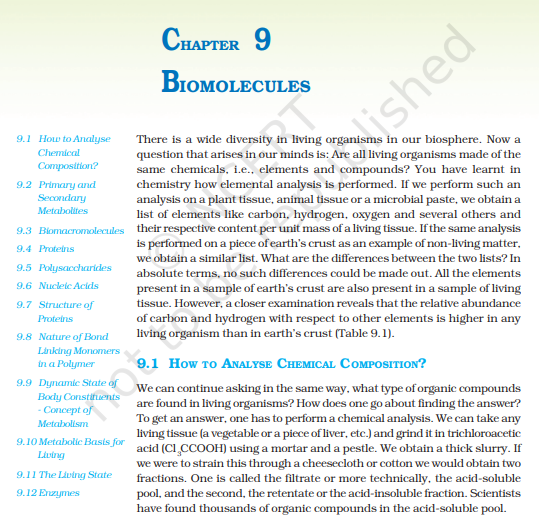‘NCERT Solutions for Class 11 Biology Chapter 9 Biomolecules’ PDF Quick download link is given at the bottom of this article. You can see the PDF demo, size of the PDF, page numbers, and direct download Free PDF of ‘Ncert Class 11 Biology Chapter 9 Exercise Solution’ using the download button.
Biomolecules NCERT Textbook With Solutions PDF Free Download

Chapter 9: Biomolecules
There is a wide diversity of living organisms in our biosphere. Now a question that arises in our minds is: Are all living organisms made of the same chemicals, i.e., elements and compounds? You have learned in chemistry how elemental analysis is performed.
If we perform such an analysis on plant tissue, animal tissue, or a microbial paste, we obtain a
list of elements like carbon, hydrogen, oxygen, and several others and their respective content per unit mass of living tissue.
If the same analysis is performed on a piece of earth’s crust as an example of non-living matter,
we obtain a similar list.
What are the differences between the two lists? In absolute terms, no such differences could be made out.
All the elements present in a sample of the earth’s crust are also present in a sample of living
tissue.
However, a closer examination reveals that the relative abundance of carbon and hydrogen with respect to other elements is higher in any living organism than in the earth’s crust.
9.1 HOW TO ANALYSE CHEMICAL COMPOSITION?
We can continue asking in the same way, what type of organic compounds are found in living organisms? How does one go about finding the answer?
To get an answer, one has to perform a chemical analysis. We can take any living tissue (a vegetable or a piece of liver, etc.) and grind it in trichloroacetic acid (Cl 3 CCOOH) using a mortar and a pestle.
We obtain a thick slurry. If we were to strain this through a cheesecloth or cotton we would obtain two fractions.
One is called the filtrate or more technically, the acid-soluble pool, and the second is the retentate or the acid-insoluble fraction. Scientists have found thousands of organic compounds in the acid-soluble pool.
In higher classes, you will learn about how to analyze a living tissue sample and identify a
particular organic compound.
It will suffice to say here that one extracts the compounds, then subjects the extract to various separation techniques till one has separated a compound from all other compounds.
In other words, one isolates and purifies a compound. Analytical techniques, when applied to the compound give us an idea of the molecular formula and the probable structure of the compound.
All the carbon compounds that we get from living tissues can be called ‘biomolecules’. However,
living organisms have also got inorganic elements and compounds in them. How do we know this? A slightly different but destructive experiment has to be done.
One weighs a small amount of living tissue (say a leaf or liver and this is called wet weight) and dries it.
All the water evaporates. The remaining material gives dry weight. Now if the tissue is fully burnt, all the carbon compounds are oxidized to gaseous form (CO2, water vapor) and are removed.
What is remaining is called ‘ash’. This ash contains inorganic elements (like calcium, magnesium, etc).
Inorganic compounds like sulphate, phosphate, etc., are also seen in the acid-soluble fraction Therefore elemental analysis gives the elemental composition of living tissues in the form of hydrogen, oxygen, chlorine, carbon, etc.
| Author | NCERT |
| Language | English |
| No. of Pages | 20 |
| PDF Size | 530 KB |
| Category | Biology |
| Source/Credits | ncert.nic.in |
NCERT Solutions Class 11 Biology Chapter 9 Biomolecules
1. What are macromolecules? Give examples.
Solution:
Macromolecules are the biomolecules that are formed by the polymerization of a huge number of micromolecules possessing higher molecular weight. Micromolecules are found in the colloidal state in the intercellular fluid due to their insoluble nature. Protein is a macromolecule.
2. Proteins have a primary structure. If you are given a method to know which amino acid is at either of the two termini (ends) of a protein, can you connect this information to the purity or homogeneity of a protein?
Solution:
Positional information of a protein is called the primary structure of the protein. The first amino acid in a protein is called the N-terminal amino acid, and the last amino acid in a protein is called the C-terminal amino acid.
Yes, we can connect this information to check the purity or homogeneity of a protein. On the basis of carboxyl and amino groups, amino acids can be acidic, basic, and neutral. Proteins can be acidic, basic, and neutral.
3. Find out and make a list of proteins used as therapeutic agents. Find other applications of proteins (e.g., Cosmetics, etc.)
Solution:
Following is the list of proteins used as therapeutic agents.
Insulin, Oxytocin, Immunoglobin, Antidiuretic Hormone( ADH), Thrombin, Fibrinogen, Renin, and streptokinases.
Some other applications are:
- Are used as artificial sweeteners. Thaumatin is a low-calorie sweetener.
- Proteins are used as dietary supplements to maintain health
- They are used in creams and shampoos
NCERT Class 11 Biology Textbook Chapter 9 Biomolecules With Answer PDF Free Download
